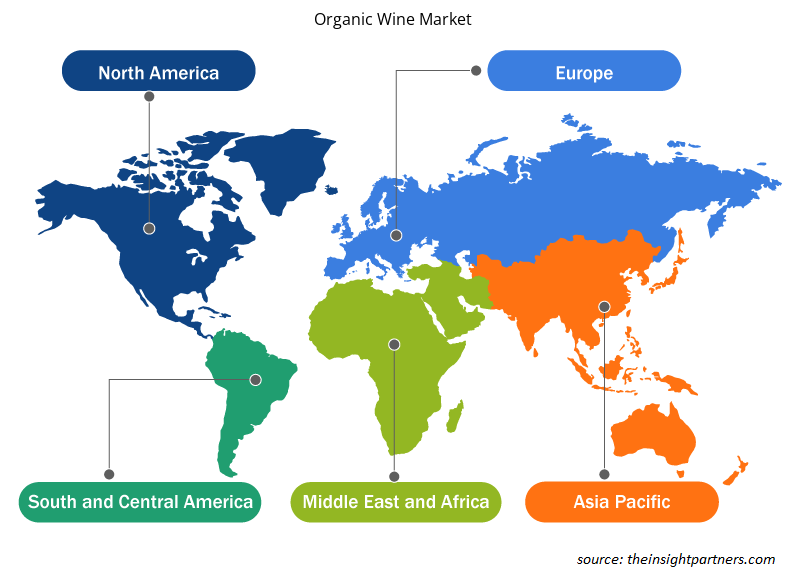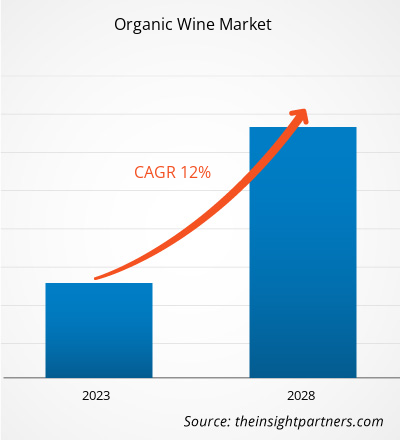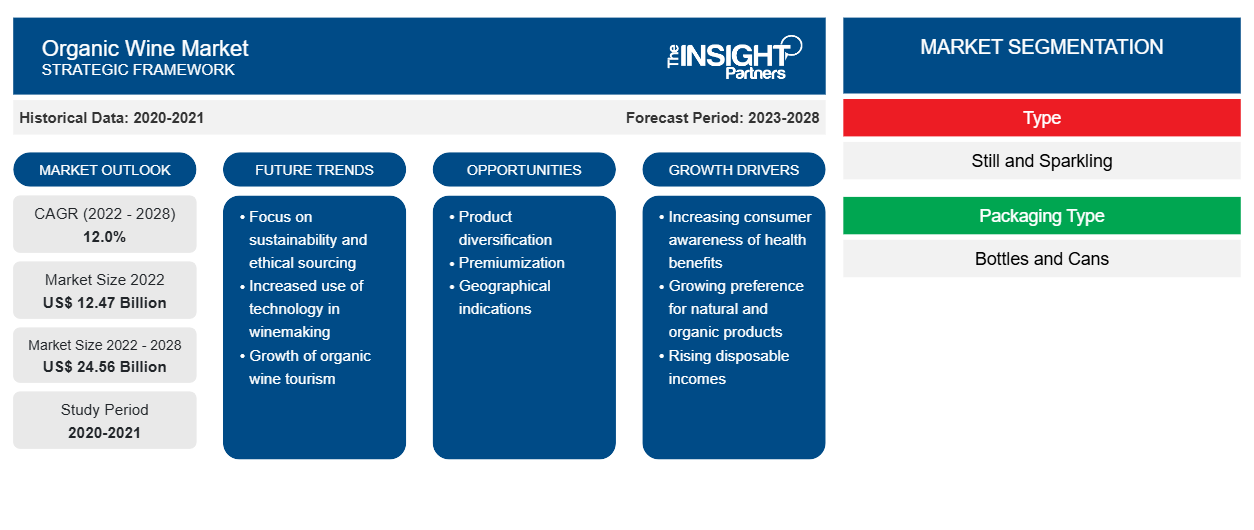Si prevede che il mercato del vino biologico raggiungerà i 24.557,14 milioni di dollari entro il 2028, rispetto ai 12.471,20 milioni di dollari del 2022. Si prevede che crescerà a un CAGR del 12,0% nel periodo 2022-2028.
La crescita del mercato è attribuita alla rapida crescita della preferenza dei consumatori per cibi e bevande biologici e sostenibili. Oggigiorno, le persone hanno sviluppato stili di vita e valori sociali, il che sta alimentando la domanda di bevande biologiche, come il vino biologico. La tecnologia digitale che consente loro di accedere a vari prodotti ha ulteriormente incoraggiato la domanda di vino biologico. Il vino biologico è disponibile in molti gusti e confezioni; ad esempio, il vino rosso, il vino bianco e il vino rosato sono confezionati in bottiglie e lattine di diverse dimensioni, il che ha aumentato il numero di opzioni per i consumatori. Inoltre, il crescente numero di iniziative dei governi a favore dell'agricoltura sostenibile ha portato a una maggiore produzione di vino biologico. La maggiore disponibilità di vino biologico e la consapevolezza dei benefici del prodotto stanno contribuendo in modo significativo alla domanda di vino biologico.
Nel 2021, l'Europa ha detenuto la quota chiave del mercato globale del vino biologico . Tuttavia, si stima che il Nord America registrerà il CAGR più elevato nel mercato durante il periodo di previsione. Il mercato del vino biologico in Nord America è segmentato in Stati Uniti, Canada e Messico. Gli Stati Uniti sono tra i maggiori consumatori di vino in volume. Secondo i dati pubblicati dalle Nazioni Unite, il Paese vanta anche un numero crescente di vigneti biologici e grandi importazioni di vino dall'Europa.
Personalizza questo report in base alle tue esigenze
Riceverai la personalizzazione gratuita di qualsiasi report, comprese parti di questo report, o analisi a livello nazionale, pacchetto dati Excel, oltre a usufruire di grandi offerte e sconti per start-up e università
-
Scopri le principali tendenze di mercato in questo rapporto.Questo campione GRATUITO includerà analisi di dati che spaziano dalle tendenze di mercato alle stime e alle previsioni.
Impatto della pandemia di COVID-19 sul mercato dei vini biologici
La pandemia di COVID-19 ha sconvolto in modo significativo il settore manifatturiero in termini di efficienza operativa, a causa di lockdown prolungati, chiusure di unità produttive, restrizioni di viaggio, divieti di commercio internazionale, interruzioni della catena di fornitura e carenze di materie prime. Ciò ha alla fine ostacolato il mercato del vino biologico. L'interruzione del settore alimentare e delle bevande dovuta al rallentamento economico causato dall'epidemia ha anche ostacolato la crescita del mercato. Tuttavia, le aziende si sono riprese poiché le limitazioni precedentemente imposte sono state allentate in vari paesi. L'interruzione temporanea seguita dalla ripresa ha portato a un'elevata crescita per il mercato del vino biologico.
L'introduzione dei vaccini COVID-19 da parte dei governi di diversi paesi ha ulteriormente alleviato la situazione, portando a un aumento delle attività commerciali in tutto il mondo. Inoltre, i governi di diversi paesi stanno pianificando di sviluppare infrastrutture moderne e tecnologicamente avanzate per mitigare gli impatti economici della pandemia di COVID-19. Durante il lockdown, i consumatori hanno acquistato il vino da soli invece di acquistarlo da hotel, ristoranti e bar, il che ha portato a un'elevata crescita delle vendite di vino biologico. Pertanto, nonostante gli effetti negativi della pandemia di COVID-19, si prevede che il mercato del vino biologico crescerà in modo significativo nei prossimi anni.
Approfondimenti di mercato
Crescente preferenza per i prodotti biologici
Il vino biologico sta diventando sempre più popolare perché è fatto da uve che rispettano le pratiche agricole biologiche. Fertilizzanti artificiali e chimici, fungicidi, insetticidi ed erbicidi non sono consentiti dagli enti governativi per la produzione. Il vino biologico è più sano perché contiene molti antiossidanti, vitamine e minerali. Il resveratrolo, presente nel vino rosso, aiuta a ridurre il colesterolo e a prevenire il cancro. Diverse organizzazioni, come USDA Organic, Demeter ed Eco Cert, regolano e supportano la produzione di vino biologico.
Informazioni basate sul tipo
In base al tipo, la dimensione del mercato globale del vino biologico è divisa in fermo e spumante. Nel 2021, il segmento fermo ha rappresentato una quota di mercato maggiore. Tuttavia, si prevede che il segmento spumante crescerà a un CAGR più elevato durante il periodo di previsione. La maggior parte dei vini fermi è sviluppata per essere bevuta subito, mentre alcuni sono prodotti per beneficiare dell'invecchiamento in bottiglia in condizioni di cantina ottimali. Questi vini biologici fermi sono realizzati con succo d'uva fermentato. Inoltre, grazie alla disponibilità di diverse varianti con spezie indotte e odori di frutta, si prevede che il vino biologico fermo registrerà un'elevata domanda. Di conseguenza, si prevede che il segmento del vino biologico fermo crescerà durante il periodo di previsione.
Avondale, Elgin Ridge Wines, Kendall-Jackson, The Organic Wine Company, Bronco Wine Company, King Estate Winery, Grgich Hills Estate, Emiliana Organic Vineyards, Società Agricola Querciabella Spa e Frey Vineyards sono i player che operano nel mercato del vino biologico. Queste aziende forniscono un'ampia gamma di portafogli di prodotti per il mercato. Le aziende sono presenti nelle regioni in via di sviluppo, il che offre opportunità redditizie per il mercato. I player del mercato stanno sviluppando prodotti innovativi e di alta qualità per soddisfare le esigenze dei clienti.
Approfondimenti regionali sul mercato del vino biologico
Le tendenze regionali e i fattori che influenzano il mercato del vino biologico durante il periodo di previsione sono stati ampiamente spiegati dagli analisti di Insight Partners. Questa sezione discute anche i segmenti e la geografia del mercato del vino biologico in Nord America, Europa, Asia Pacifico, Medio Oriente e Africa e Sud e Centro America.

- Ottieni i dati specifici regionali per il mercato del vino biologico
Ambito del rapporto sul mercato del vino biologico
| Attributo del report | Dettagli |
|---|---|
| Dimensioni del mercato nel 2022 | 12,47 miliardi di dollari USA |
| Dimensioni del mercato entro il 2028 | 24,56 miliardi di dollari USA |
| CAGR globale (2022 - 2028) | 12,0% |
| Dati storici | 2020-2021 |
| Periodo di previsione | 2023-2028 |
| Segmenti coperti |
Per tipo
|
| Regioni e Paesi coperti |
America del Nord
|
| Leader di mercato e profili aziendali chiave |
|
Densità degli attori del mercato del vino biologico: comprendere il suo impatto sulle dinamiche aziendali
Il mercato del vino biologico sta crescendo rapidamente, spinto dalla crescente domanda degli utenti finali dovuta a fattori quali l'evoluzione delle preferenze dei consumatori, i progressi tecnologici e una maggiore consapevolezza dei benefici del prodotto. Con l'aumento della domanda, le aziende stanno ampliando le loro offerte, innovando per soddisfare le esigenze dei consumatori e capitalizzando sulle tendenze emergenti, il che alimenta ulteriormente la crescita del mercato.
La densità degli operatori di mercato si riferisce alla distribuzione di aziende o società che operano in un particolare mercato o settore. Indica quanti concorrenti (operatori di mercato) sono presenti in un dato spazio di mercato in relazione alle sue dimensioni o al valore di mercato totale.
Le principali aziende che operano nel mercato del vino biologico sono:
- La società Kellogg
- Avondale
- Vini di Elgin Ridge
- Kendall Jackson
- L'azienda vinicola biologica
Disclaimer : le aziende elencate sopra non sono classificate secondo un ordine particolare.

- Ottieni una panoramica dei principali attori del mercato del vino biologico
Segnala i riflettori
- Tendenze progressive del settore nel mercato dei vini biologici per aiutare gli operatori a sviluppare strategie efficaci a lungo termine
- Strategie di crescita aziendale adottate dai mercati sviluppati e in via di sviluppo
- Analisi quantitativa del mercato del vino biologico dal 2020 al 2028
- Stima della domanda globale di vini biologici
- Analisi delle cinque forze di Porter per illustrare l'efficacia degli acquirenti e dei fornitori che operano nel settore
- Sviluppi recenti per comprendere lo scenario competitivo del mercato
- Tendenze e prospettive di mercato e fattori che guidano e frenano la crescita del mercato dei vini biologici
- Assistenza nel processo decisionale evidenziando le strategie di mercato che sostengono l'interesse commerciale, portando alla crescita del mercato
- La dimensione del mercato dei vini biologici nei vari nodi
- Panoramica dettagliata e segmentazione del mercato, nonché dinamiche del settore dei vini biologici
- Dimensioni del mercato dei vini biologici in diverse regioni con promettenti opportunità di crescita
"Global Organic Wine Market Analysis to 2028" è uno studio specializzato e approfondito del settore alimentare e delle bevande con un'attenzione particolare all'analisi delle tendenze del mercato globale del vino biologico. Il rapporto mira a fornire una panoramica del mercato con una segmentazione dettagliata del mercato.
Il mercato del vino biologico è segmentato in tipo, tipo di imballaggio, canale di distribuzione e area geografica. In base al tipo, il mercato è diviso in fermo e spumante. In base al tipo di imballaggio, il mercato è suddiviso in bottiglie e lattine. In base al canale di distribuzione, il mercato è segmentato in supermercati e ipermercati, negozi specializzati, vendita al dettaglio online e vendita diretta. In base all'area geografica, il mercato è ampiamente segmentato in Nord America, Europa, Asia Pacifico (APAC), Medio Oriente e Africa (MEA) e Sud e Centro America.
Profili aziendali
- Avondale
- Vini di Elgin Ridge
- Kendall Jackson
- L'azienda vinicola biologica
- Azienda vinicola Bronco
- Cantina King Estate
- Tenuta di Grgich Hills
- Vigneti Biologici Emiliana
- Società Agricola Querciabella Spa
- Vigneti Frey
- Analisi storica (2 anni), anno base, previsione (7 anni) con CAGR
- Analisi PEST e SWOT
- Valore/volume delle dimensioni del mercato - Globale, Regionale, Nazionale
- Industria e panorama competitivo
- Set di dati Excel
Report recenti
Rapporti correlati
Testimonianze
Motivo dell'acquisto
- Processo decisionale informato
- Comprensione delle dinamiche di mercato
- Analisi competitiva
- Analisi dei clienti
- Previsioni di mercato
- Mitigazione del rischio
- Pianificazione strategica
- Giustificazione degli investimenti
- Identificazione dei mercati emergenti
- Miglioramento delle strategie di marketing
- Aumento dell'efficienza operativa
- Allineamento alle tendenze normative























 Ottieni un campione gratuito per - Mercato del vino biologico
Ottieni un campione gratuito per - Mercato del vino biologico